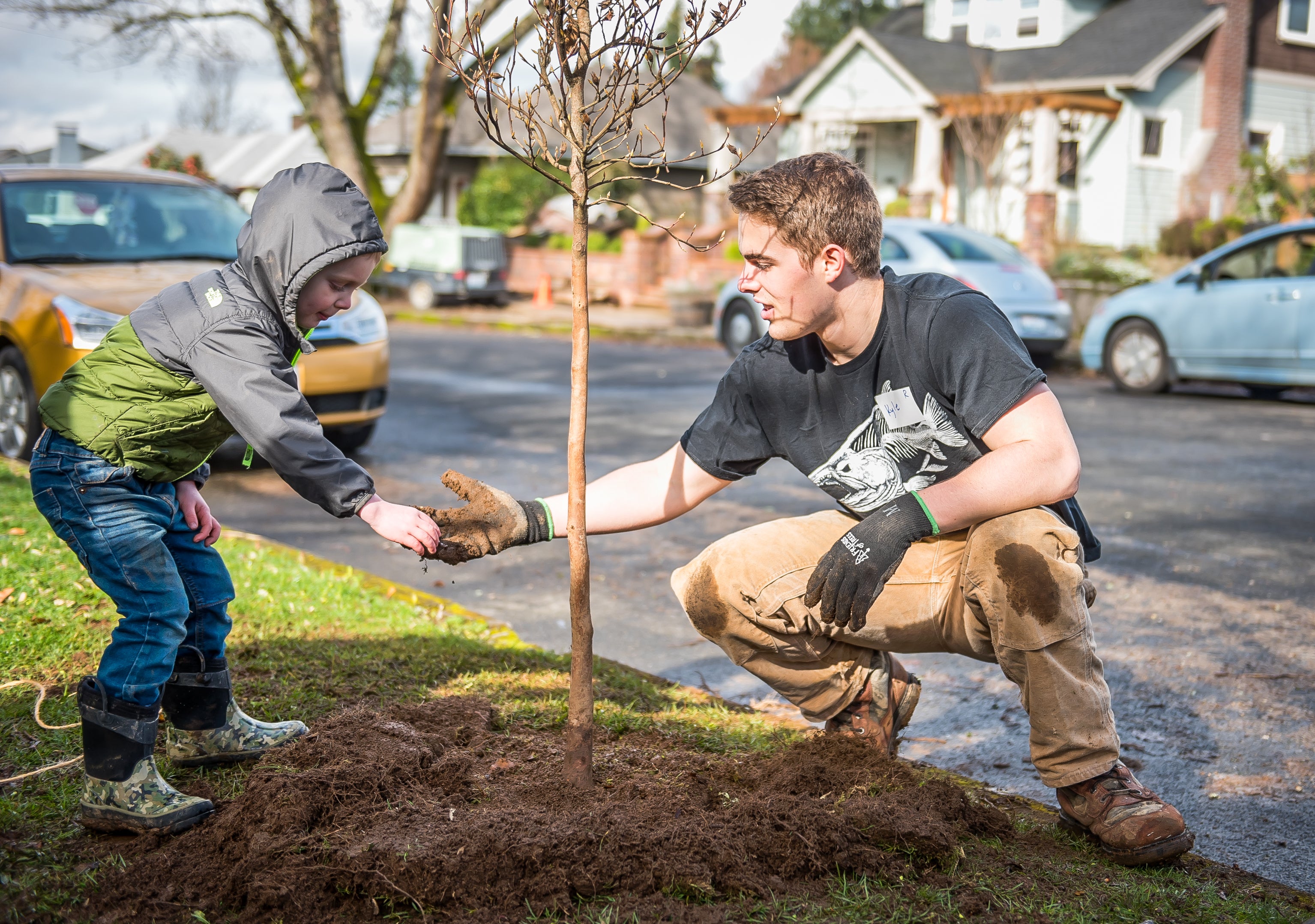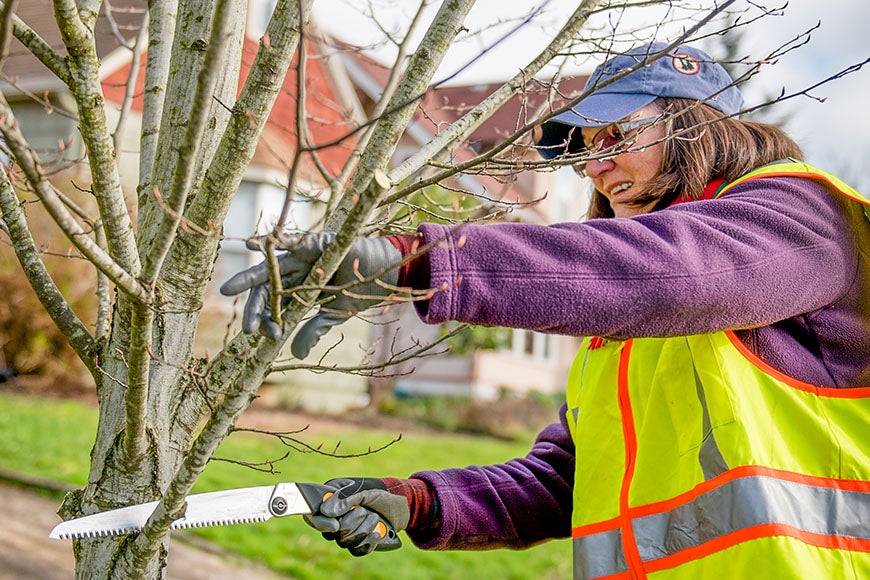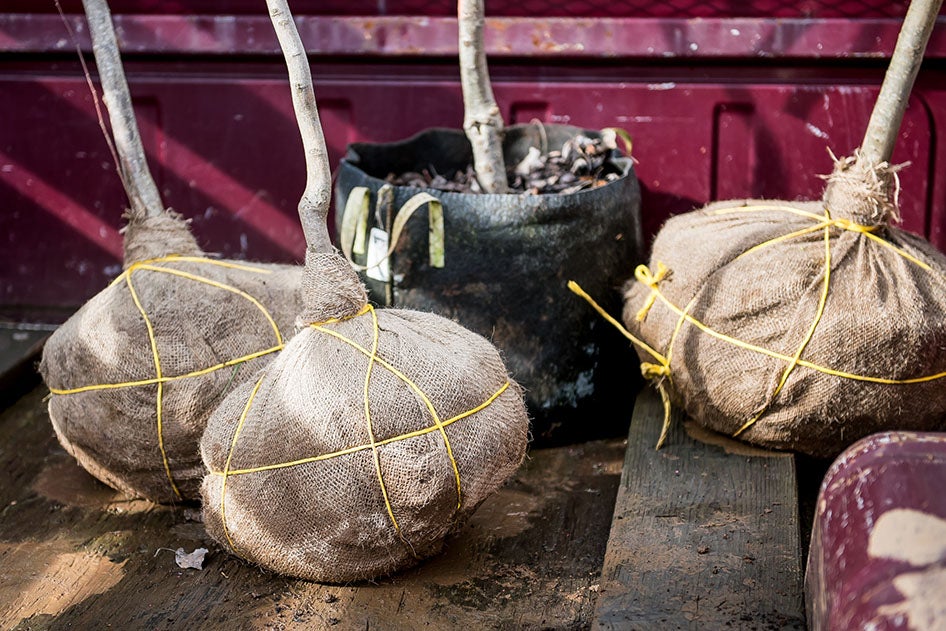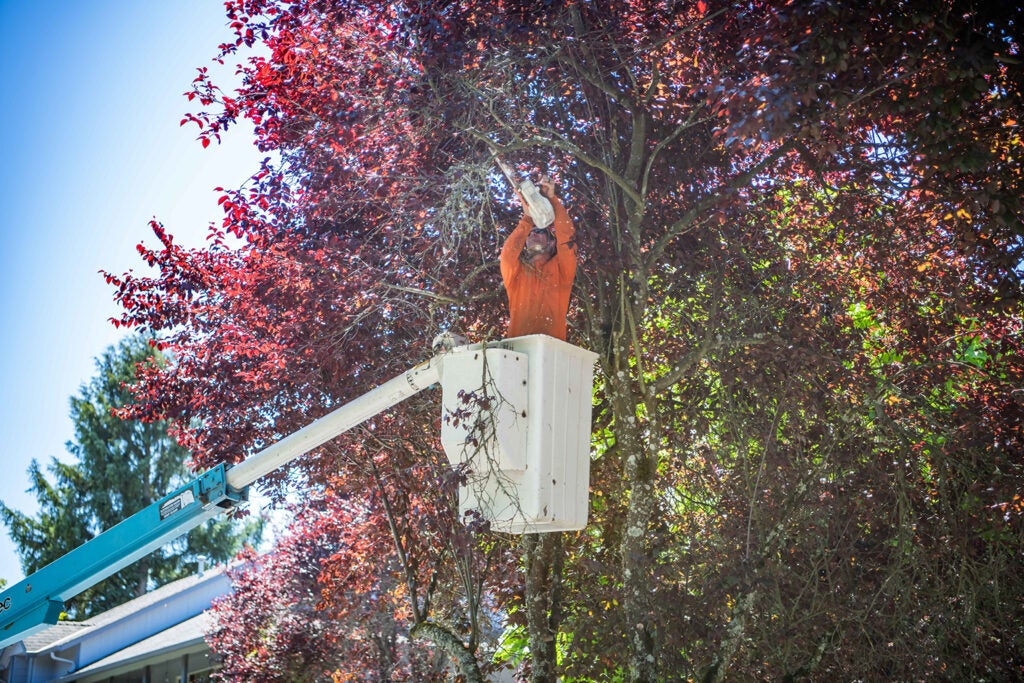Tree Care and Proper Pruning

Tree Care
Trees are vital to our community. Once your tree is established, help it flourish! It’s important to provide structural pruning and care to ensure it thrives for years to come.
Young tree care
Pruning a young tree is essential for establishing a healthy structure and promoting proper growth. Here’s a general guide on how to prune a young tree:
- Timing: Pruning is typically done during the dormant season, which is late fall to early spring, depending on the tree species and local climate. Avoid pruning during periods of active growth to minimize stress on the tree and susceptibility to pests.
- Tools: Use sharp, clean pruning tools such as hand pruners, loppers, and pruning saws. This ensures clean cuts that heal quickly, reducing the risk of disease.
- Identify Goals: Before pruning, identify your objectives. Common goals for pruning young trees include removing dead, damaged, or diseased branches, shaping the tree for proper structure, and promoting a central leader (main trunk) or desired branching pattern.
- Remove Dead or Diseased Branches: Start by inspecting the tree for any dead, damaged, or diseased branches. These should be pruned back to healthy tissue, making clean cuts just outside the branch collar (the swollen area where the branch connects to the trunk or larger branch).
- Remove any suckers growing from the base of the tree.
- Establish Central Leader (if applicable): Many trees benefit from a central leader, a single dominant vertical stem. If your tree is supposed to have a central leader (e.g., many deciduous trees and conifers), select the strongest, most vertical branch to serve as the leader. Remove competing branches that could interfere with its growth.
- Thin Out Crowded Branches: Remove any branches that are crossing, rubbing against each other, or growing in undesirable directions. Thin out branches to improve airflow and light penetration within the canopy.
- Maintain Balance and Proportion: Step back periodically to assess the tree’s overall shape and balance. Avoid removing more than 15% of the tree’s canopy in a single season to prevent excessive stress.
- Prune Conservatively: It’s better to under-prune than over-prune, especially with young trees. Avoid drastic pruning cuts that remove large portions of the canopy or disrupt the tree’s natural shape.
- Monitor and Maintain: After pruning, monitor the tree’s growth and health regularly. Address any issues that arise promptly, and continue to prune as needed to maintain the desired structure and health of the tree.
- If you’re unsure about how to prune your specific type of tree or if the tree requires specialized pruning techniques, consider consulting with a certified arborist for guidance. They can provide expert advice tailored to your tree’s needs.
Summer tree care
During the summer, newly planted trees require 10 to 15 gallons of water every week. Mature trees should be deeply watered once a month. Water your established trees with 10 gallons per one inch of trunk diameter. Use bark mulch around tree bases to hold in moisture.
Check out our summer tree care video to learn how to properly care for your tree during the hot summer season!
Winter tree care
A common question of homeowners after a storm is: “Will my tree survive?” This is a difficult question to answer because it is affected by several factors of the tree’s former and current condition. Some trees seem to be able to come through with only minor damage, while others suffer the loss of large limbs and significant parts of their branching structure.
Proper pruning and maintenance are the best defense against storm-related tree damage.
Call 360-487-8332 or send us an email for more information.
Handling invasive species
Some species of trees may thrive in locations that conflict with city infrastructure or private property. Learn how to identify common invasive trees and effective strategies for management.
Pruning
To preserve our tree canopy, proper tree care is essential. With 62% of the City’s trees on private property, it’s imperative that the community knows how to properly take care of trees and why tree care is so important.
Get involved: Interested in getting pruning or planting experience? Check out our events calendar or contact us.

Proper pruning
Proper tree care not only promotes the health and longevity of the tree, it also protects the property owner. Improper pruning can put a tree on a negative cycle where frequent maintenance is required, which is expensive. On the other hand, a properly pruned tree may not need additional pruning for seven to ten years, or more. Properly maintained trees are also less susceptible to damage in storms and are less likely to be hazardous to persons or property. Properly maintained trees look nicer and increase property values. Learn more about proper pruning from Friends of Trees.
What is topping?
Topping is widely recognized as harmful and inappropriate by arborists and tree care experts; unfortunately, this practice is still widespread in Vancouver.
Topping is the drastic removal of large quantities of leaves and branches from a tree’s crown.
According to the International Society of Arboriculture (ISA), “topping is the indiscriminate cutting back of tree branches to stubs or lateral branches that are not large enough to assume the terminal role.”
Other names for topping:
- Heading
- Tipping
- Hat-racking
- Rounding over
Topping:
- Hurts trees.
- Is expensive.
- Creates unsafe, hazardous conditions.
- Shortens the life of a tree.
Myth busting
Myth: “Topping rejuvenates the tree.”
Fact: Actually, topping removes large amounts of energy-converting foliage from the tree. This forces the tree to tap energy reserves as it tries to replace the lost foliage, weakening the tree. A weakened tree is more vulnerable to attacks by pests and disease.
Myth: “Topping makes the tree fuller.”
Fact: In fact, many trees will send out or flush large amounts of foliage to replace the missing leaves. New growth is dense and may appear to be fuller, but those new branches are poorly attached and can easily break. Plus, topped branches are open for attacks by pests and decay.
Myth: “Topping is more affordable.”
Fact: A topped tree requires more maintenance because you have to prune it more often. Ultimately, the tree will die prematurely, reducing your property value and possibly even the character of your neighborhood. Then, you end up having to pay for the dead tree to be removed and replaced.
Myth: “All of my neighbors top.”
Fact: Research has shown how proper pruning techniques work with a tree’s biology, not against it. Many of your neighbors already know this, and if they don’t, you can help them learn!
Myth: “New growth is stronger.”
Fact: The new growth after topping usually grows faster, but it is not stronger. Instead, the new growth is poorly attached and easily breaks off, increasing the risks of storm damage and personal liability.
Myth: “The tree casts too much shade.”
Fact: The canopy of a tree may be thinned to allow in more sunlight by using proper pruning techniques that don’t damage the tree like topping does.
Myth: “The tree got too big.”
Fact: Trees have a genetic disposition to be a certain size and seldom deviate beyond their genetic parameters. However, their placement within the context of your neighborhood or property may affect its preferrable size. If tree size is a concern, consider your selection. Plant trees that will fit the available space when they reach maturity.
More reasons not to top your tree
- “Tree-Topping: The Cost is Greater Than You Think” – PennState Extension, 2022
- “Why Topping Hurts Trees” – Trees Are Good website & International Society of Arboriculture, 2021
What are some alternatives to topping?
Plant the right tree in the right place. Carefully select the appropriate species before you plant a tree. Bear in mind the mature size of the tree and avoid planting trees that will cause future conflicts with infrastructure, utilities, structures or views.
Prune properly to allow your trees to realize their full potential for health and beauty in the landscape. Proper pruning removes excessive growth without leaving the tree vulnerable. After a proper pruning, you usually can wait 10 to 15 years before they will need to be pruned again, whereas if you top your trees, you may have to prune your trees every few years.
Enhance views by windowing, crown raising or using other, healthy pruning techniques. There are many excellent methods to manage tree growth without hurting the tree. Here are a few:
- Windowing removes several branches symmetrically within an area of the tree. By carefully choosing which branches to cut, and making proper pruning cuts, you can leave a window in a tree that provides a fully-framed view and also maintains the health of the tree.
- Crown raising or skirting removes lower branches to open up a view. To maintain a healthy tree, never remove more than 25% of the canopy at one time and retain at least 2/3 live crown ratio.
- Crown cleaning removes dead, dying, diseased, crowded, weakly-attached or low-vigor branches.
- Crown reduction or drop-crotching removes larger branches at the top or side of a tree when its size absolutely must be reduced, such as when utility lines are competing for space. (This is the method that Clark Public Utilities uses to maintain their utility lines.) Be sure to use proper pruning cuts above a lateral branch that will increase in size after cutting.
Ready to learn more about proper pruning? Check out this
article from the Washington State Department of Natural Resources: Remove the 3 D’s from your trees; learn what, when and how to prune
How you can make a difference
By taking care of our existing trees and planting more, we maximize the community benefits of our urban forest. There are many ways you can enhance the health and beauty of our community:
- Contact us to schedule a presentation to give to your group.
- Print out this No Topping poster and display in your break area, business window, or other high traffic area.
- Include information in your newsletter or publication about the hazards of topping. We can provide a short article for your publication.
- Hire a professional arborist that is licensed and bonded, and ask plenty of questions about their business practices.
- Become a Neighborhood Tree Steward and help preserve our urban forest.
- Let the neighborhood know topping is bad with a yard sign; contact Urban Forestry to find out how to get one.
- Attend one of the many upcoming events where you can visit with Urban Forestry and get involved.
- Do you have a good idea on how to inform others that topping is not the right solution? We’d love to hear it.

Planning and Permitting
Thinking about planting, trimming or removing a tree on your property?
Obtaining permits
In Vancouver, permits may be required for planting, pruning, or removal of trees. Because Vancouver loves trees, failure to obtain a permit before starting work will result in a violation and monetary fines. Check for appropriate permits before removing any tree or performing any pruning or maintenance on a street tree.
Hiring a professional
For all tree work, hire a qualified tree care provider (ISA-certified arborist) to ensure proper care of your valuable assets, to minimize future maintenance needs and costs, and to reduce hazards.
The American National Standards Institute (ANSI) has established tree care standards for the tree care industry, known as ANSI A300, these standards are strictly adhered to by true tree care professionals. Always insist that your arborist follow the appropriate A300 guidelines.
A Street Tree Worker License is required to perform major pruning on street trees. View the list of companies possessing a current, valid Street Tree Worker License.
Proactive Pruning
Our Vancouver Urban Forestry team proactively prunes trees in public parks and street trees along roadways scheduled for pavement work.

This proactive pruning helps enhance overall tree health and improve structure. Trimming street trees prior to pavement work also provides safe clearance for equipment.
Trees help shade parks and streets. This cools our neighborhoods and extends the life of street pavement. Each year Urban Forestry coordinates with the Pavement Management Program to proactively prune street trees during February through June.

